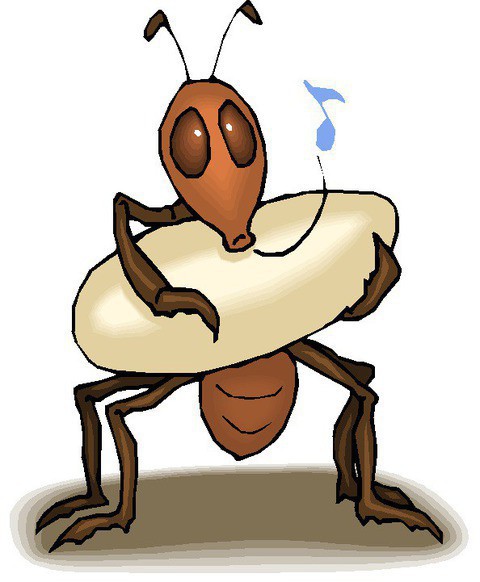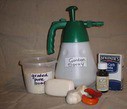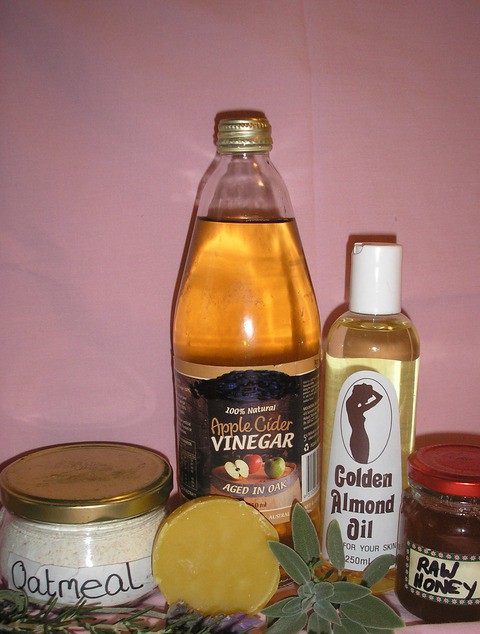The Shoppe Newsletter No. 58
In this Issue:
- Non-chemical Insect Repelling
- Never Fail Garden Spray
- Beware: Chemicals in Skin Care Products
- Making beeswax lip salve with just 2 ingredients
- Product of the Month: Talcum Powder
- Recipe: Talc alternative in a jar
- Apricot Jam from Dried Apricots |
| | Welcome to another issue of The Shoppe Newsletter – I hope you are all well and enjoying the last days of warm weather before we head into winter and some cold days and nights. If you would like to know more about The Self-Sufficiency Shoppe and what I do check-out my web-site: www.theshoppe.com.au Pam – The Self-Sufficiency Shoppe
|
| | Non-chemical Insect Repelling
Not as easy as chemicals – but worth the effort!
|
| |  |
I’m asked many times about natural insect repellents. It seems, like me, many people are concerned about the use of chemicals when dealing with insect problems. Luckily, there are many natural options – however the bottom line is that nothing works better than a good ‘hit’ of chemicals to solve an insect problem. Chemically based insect applications are specifically created and tested to deal with the problem head-on. But there is, of course, a price to pay for using chemicals – in the home, for our health and for the environment. So if you’re really determined to follow the natural approach prepare yourself for the fact that it will require some extra time and effort to deal with the problem – but well worth it. I think it’s a little irresponsible to have a complete ‘eradication and annihilation’ approach to insect problems considering that insects are just a much a vital part of planetary habitation as humans – although insect habitation is a lot less disruptive toward the planet! We must all find a way to live on this planet together in harmony – so I prefer the approach of encouraging the little beings to take their business elsewhere as opposed to death and destruction.
So interested am I in a natural approach to insect repelling I have put together an e-book (No. 20 – Natural Insect Repellents) which covers many more options – see details later. In the mean time I’ve collated a few suggestions from e-book No. 20 for dealing naturally with some common household insects:
|
| | First - Remove the Cause: Insect congregate where this is a food or habitation source. Removal of the attraction will do much to solve the problem. Cover compost bins, seal water tanks, remove water sources, give attention to cleanliness, use sealed packaging when storing food, close access points (doors, windows and openings), etc. are the first steps.
Ants: Boiling water or hydrated lime (from the hard-ware store) over their nest will ‘encourage’ them to move elsewhere. Moth balls inside pantyhose hung in the bin will discourage fossicking ants. They will (apparently) not cross a chalk line – draw a thick chalk line around their usual haunts to keep them under control. Talcum powder will also discourage ants. (Some ‘natural’ remedies suggest using borax – however borax is toxic in large doses for children and pets – for that reason I choose not to leave it laying around in the garden to deal with ant problems. I’ve also tried spraying the nest with undiluted vinegar – which discouraged them temporarily).
Fleas: fleas detest mint – throw fresh mint cuttings where the pet sleeps. Vacuum thoroughly to remove eggs from carpets and mats. Sprinkle with eucalyptus oil to deter their habitation in certain areas. Control fleas on your pet. (See e-book No. 35 – Natural Pet Care for more natural flea repellent ideas and recipes)
Cockroaches: Talcum powder or Epsom salts will deter cockroaches (which dislike walking on grainy powder). In the olden days it was believed that fresh cucumber also deterred cockroaches. Dishes containing bicarb soda and icing sugar will destroy cockroaches (who nibble the mix).
Homemade cockroach traps: Leave old margarine tubs (containing a few remaining dregs of margarine) in areas where cockroaches frequent. They will crawl into the tub to savour the margarine, only to find the walls too slippery for escape. (A little sherry, piece of cake or bread, in the container will hasten their attraction to the trap).
Hot Powder: chilli powder or pepper sprinkled in problem areas will deter crawling insects (ants, silverfish and cockroaches)
|
| Flies: Try a fly swatter - it's cheap, economical and very environmentally safe (no chemicals!).
Weevils:
Thoroughly clean out food storage areas. Make sure all dry food is
stored in sealed containers. To ensure any remaining weevil eggs (usually on the
outside of the packages) are destroyed place suspect food in freezer
over-night before storing.
Moths & Silverfish: Line drawers and
cupboards with sheets of newspaper that have been sprinkled with
lavender or citronella essential oil.
Personal Insect Repellent: Rub
or spray cider vinegar onto the skin to make it ‘unpalatable’ to
insects - such as mosquitoes. There are also a couple of species of
plants, such as the citronella scented pelargonium that, when brushed
across the skin, will act as a natural repellent.
|
| | Insects in the Garden:
It’s important in terms of ‘harmony in the garden’ not to eradicate all
garden insects with powerful repellents – some do a wonderful job at
maintaining insect numbers to benefit the garden. So a gentle
non-chemical approach is best. Here’s a useful soap-based spray that
is safe to use: |
|  |
Recipe: 'Never-Fail Garden Spray'
Make up a mixture of 100g grated soap dissolved in 300ml boiling water – blend and leave to cool to form a thick jelly. Add 8 litres of hot water and dissolve. Pour into recycled spray bottles and spray onto garden plants. To make the spray a more effective insect repellent soak garlic cloves and hot fresh chilli in the mixture before using. (Tie into a small bag so that it is easier to remove – do not use crushed or powdered chilli/garlic as it will block the sprayer). Two tablespoons of eucalyptus oil may also be added.
(This mix will need to be used more frequently then chemically based sprays – about once fortnightly – in order to be effective. Suited to sucking and biting insects such as white-fly, aphids, caterpillars, etc. who dislike to taste of soap).
Recipe: Slug and snail deterrent
Make up a strong coffee spray consisting of one part brewed coffee with 10 parts water. Spray onto plants and surrounding soil frequented by slugs and snails to discourage them.
Earwigs: Eradicate from the garden by leaving a loosely folded newspaper in the garden overnight. In the morning the earwigs will have crawled into the paper (which can now be disposed of in the recycling bin)
Companion Planting: Some garden plants are well-known for their insect repelling characteristics. e-Book No. 78: Companion Planting in the Garden contains a useful table covering common garden vegetables, fruit and herbs/plants and recommended companion plants (for insect deterring and growth enhancement).
You’ll find lots more insect repelling information in the following e-books:
|
| | | No. 20 - Natural Insect Repellents, Deterrents & Killers: All natural safe methods using common household resources. Covers: ants, cockroaches, fleas & mites, flies, mice, mosquitoes, moths, silverfish, weevils. Presented in two stages: Prevention/deterring and/or extermination. Includes recipes and suggestions for personal insect repellents. 24 pages Price: $12.00 For download information click here |
| | | No. 21 - Safe Organic Sprays for Home and Garden: Easy-to-make sprays using common household ingredients. Covers sprays for cleaning, insect repelling, disease prevention (plants), plant nourishment using such sources as: lemon juice, vinegar, eucalyptus oil, citronella, onion, garlic, milk, chilli, soap, pepper, coffee, flour, herbs, seaweed, bicarb soda and more! 19 pages Price: $12.00 For download information click here |
| | No. 35 - Natural Pet Care: Chemical free, money saving and practical. Includes homemade dog and cat food, dog biscuits, healthy food options, making a birdseed cake, natural insect repellents, homemade flea collar, deterring pets from the garden (and furniture!), dealing with bad breath, puppy care, fur-balls, and more. 23 pages Price: $12.00 For download information click here
|
| | Chemical Free Options e-Book Set download
Chemical free options for common household products - including skin creams & salves, polish, paint, insect repellents, glues and putties, food colours and dyes, pet care products.
Contains 7 e-Booklets: No. 4 – Making Beeswax Products, No. 6 – Making Whitewash, No. 20 – Natural Insect Repellents, No. 18 – Homemade Glues, Pastes & Putties, No. 75 – Natural Colours and Dyes, No. 55 – Handyman Hints, No. 35 – Natural Pet Care.
|
| | Beware: Chemicals in Skin-Care Products
Many people mistakenly believe that if the product is available commercially and ‘approved’ by the manufacturer it must be safe to use. |
| |  |
At one of my recent Natural Skin Care Workshops two young ladies commented that when they used facial cleansing wipes their skin would become bright red and sometimes itch. It was quite apparent that this is a reactive response to the chemicals in the product they were using. When a reaction occurs it is important to STOP using the product immediately – because it can be potentially damaging not only to the skin but to general health (everything is absorbed through the skin into the body). Many people mistakenly believe that if the product is available commercially and ‘approved’ by the manufacturer it must be safe to use. Not necessarily so – chemicals in skin care products can be dangerous and cause reactions. So what’s the solution? Use natural applications that work ‘with’ the body instead of against it – for example as a natural skin cleanser use oatmeal and water. That’s as natural as it comes! It’s safe, totally chemical free and cheap!
At about the same time an interesting question was raised in ‘What’s Your Problem’ in the local newspaper about the safety of chemicals in products which made very interesting reading:
“Q. My health concern is that our skin is porous and therefore able to transport bad elements through our systems. I worry that the affects may manifest years later in life.
A. Many reports highlight the dangers of chemicals in products we use daily and we need to read the labels and be aware of damage to our own health and the environment. If you analysed the contents of your average bathroom, laundry or even kitchen products, you might discover some of the known carcinogens that are banned overseas and yet we still use them in our products. Reading product labels to ensure that products are used correctly and stored correctly is essential. The average woman applies 500 chemicals a day to her body. Lipstick can contain up the 9 different metals and if used twice a day provides moer the 20 per cent of a personal acceptable daily (DI) of aluminium, cadmium and manganese. Some exceeded the ADI for chromium, a metal that has been linked to stomach tumours. Over-exposure to some chemicals has been linked to toxicity in the nervous system and cancer. For years, we have been warned about the possible side-effects of parabens – synthetic preservatives used in toothpaste, shampoos, facial wipes, etc. – and sodium lauryl sulfate (which creates foam)”.
(From 'The Advertiser' 19/1/15)
|
| |  |
The Alternatives: Chemical Free Skin Care
It seems a huge contradiction in terms to use chemicals (which are alien to the natural body) in an effort to achieve healthy, ageless & beautiful skin! The basic philosophy behind my Natural Skin Care approach (via my workshops and publications) is that effective skin-care can be achieved by using just five basic ingredients:
1. Oatmeal
2. Cider Vinegar (or lemon juice)
3. Almond Oil
4. Herbs (rosemary, thyme & sage, etc.)
5. Honey/Beeswax.
All non-toxic, very cost effective and not tested on animals! No need for any other commercially purchased products or chemicals. Oatmeal is a natural chemical-free, soap and detergent free cleanser. Cider vinegar (diluted) is a natural anti-bacterial toner and astringent. Herbs, almond oil, honey and beeswax all have their own positive attributes for natural skin care. For more information about natural skin care: go to my web-page ‘Natural Skin Care’
More detailed information about Natural Skin Care in the following downloads:
|
| | | e-book No. 30 Natural Skin Care: Natural economical alternatives to commercial skin-care products using 5 basic ingredients: oatmeal, vinegar/lemon, herbs, almond oil and beeswax/honey for all your skin care requirements - cleansers, scrubs, masks, astringents, toners and moisturiser. Plus other alternatives using what's available in the garden or kitchen. Price: $12.00 Click here for download information |
| | e-book No. 13 - Simple Salves & Creams: Basic procedure - step-by-step for making face creams and lip salves. Outlines difference between salve and cream, lip salve and cream recipes (with flavour variations), methods for making a skin creams, possible problems and how to rectify them, how to make a herbal infusion, suitable herbs for skin types, and more. 15 pages Price: $8.00 Click here for download information |
| | Natural Skin Care e-Book Set download
Contains 5 e-booklets - No. 30 Natural Skin Care, No. 13 Making Simple Salves and Creams, No. 26 Beautiful Hands, No. 58 Old-time Oatmeal, No. 37 Beautiful Baths
|
| | Natural Skin Care Workshops:
I regularly run my Natural Skin Care Workshops encouraging people to switch to natural skin care techniques. Workshops are very practical with take home products. Not surprisingly it is the most popular of all my workshops. The next Natural Skin Care Workshop is at Brighton (Adelaide - South Australia). Go to: Upcoming Workshops and Events for more info.
If unable to come to a workshop you can download the complete workshop format from my website - here's the details:
|
| | Natural Skin Care Workshop download
Make your own skin care products using ingredients from the home and garden!
Complete natural facial skin care regime (cleanser, astringent, moisturiser) using affordable, safe and
environmentally friendly ingredients
----------------------------
----------------------------
34 page PDF download - Price: $25.00To download go: 'Natural Skin Care' web-page (click on 'Add to Cart' for 'Workshop@Home Natural Skin Care' to download) |
| | Making Beeswax Lip Salve:
Lip salve is one of my most popular pre-made products I sell at events and workshops. It’s so easy to make at home - here’s a simple lip salve recipe using just two ingredients – beeswax and olive oil.
Recipe: Simple Beeswax Salve: Melt 30grams beeswax in a double boiler*. Remove from heat. Add 60grams olive oil. Mix well. Pour into small glass jars or containers and leave to set.
Honey Lip Salve: Add 1/2 teaspoon good honey to the melted beeswax and olive oil mix. (Honey is very healing for the skin and ideal as an additive to lip salve).
*Take care melting beeswax – if it becomes over-heated it will catch alight. Beeswax is best melted in a double boiler. (Recipe from e-Book No. 4 Making Beeswax Products)
You’ll find more lip salve recipes and other products made with beeswax in:
|
| | e-book No. 4 – Making Beeswax Products: Beeswax is a wonderfully natural medium that has many hidden (and forgotten) uses. It seals, coats, preserves, emulsifies (for polishes and cosmetics), water-proofs and much more. This booklet contains recipes for making furniture polish (various recipes), skin moisturisers and cleansing creams, lipstick, lip salve, deodorant cream, shoe cleaner, sealing wax, waterproofing medium & more. 25 pages Price: $12.00 Click here for download information
|
| |  |
Product of the Month: Talcum Powder (Talc)
Talcum powder is my chosen ‘Product of the Month’ NOT because it has any particular beneficial attributes but to alert people to its potential harmfulness when used on the body. Why? Talc has links to health problems such as cancer and asthma. There is increasing concern that the fine particles of talc can irritate the respiratory system and, like asbestos particles, settle in the lungs and other organs causing possible long term problems.
The other issue about talc is that it is a mined substance that exploits the earth's resources. It’s a common component in commercial cosmetics, beauty products (eye shadows, lipstick), baby products, animal products (including as a ‘filler’ for cattle feed), and much more – all of which use precious resources from the Earth that take many thousands of years (and longer) to replace. Plus talc contains added chemicals – such as anti-caking agents and fillers – further adding to the chemical over-load your body has to find a way to deal with.
|
| | The Alternatives:
Rice flour is safe non-allergenic alternative. It’s also cheaper and less exploitative in terms of the environment. Other alternatives are: corn flour (corn starch), bicarb soda, oat flour, powdered dried flowers (lavender, rose, chamomile, and calendula) and arrowroot powder.
Recipe: Talc Alternative in Recycled Jar: Pour 1 cup rice flour into a clean small to medium sized jar with metal lid. For plain ‘talc’ leave as it is. For scented ‘talc’ add 8-10 drops essential oil (such as lavender) or chopped fresh or dried herbs or flowers. Pierce holes in lid to allow for easy sprinkling. (If using dried or fresh flowers for herbs – use ½ cup plant material per 1 cup rice flour – place in blender or food processor and pulp to a fine powdery consistency).
|
| | Uses for Talc Powder
Received talc as a Christmas gift and don’t know what to do with I it? Don’t throw it away – it’s a precious resource from the earth. Luckily it has many other less harmful uses – but take care not to inhale the fine powder…….
Ant deterrent: Ants don’t like the feel and smell of talc – so sprinkle it around ants' nest or walkways to keep them away. (Obviously ants are more perceptive than humans when it comes to adverse effects of chemicals!).
Remove grease and oil from fabrics, carpets, clothing by sprinkling first with talcum powder. Cover with brown paper or kitchen paper. Iron with a hot iron. The grease will be absorbed into the paper. Repeat the process if necessary
Remove grease spots from wallpaper by dabbing the area with talcum powder (with a cotton wool ball). Leave for one hour, then brush off.
Freshen old mouldy or smelly books by lightly sprinkling with talc. Also works well with greasy or oily playing cards.
Solve the problem of squeaky floor boards by sprinkling the cracks with talcum powder. It helps eliminate the ‘squeak’.
Sprinkle talc onto tight knots (such as shoe laces and fine jewellery) – it makes untangling or untying the knot a lot easier.
|
| | Apricot Jam from Dried Apricots
Not everyone has easy access to fresh produce to make yummy homemade jam. However some fruits lend well to making jam in their dried form - particularly apricots. Here's my recipe for making apricot jam from dried apricots.
Ingredients: 1 kilogram dried apricots, 2 ½ litre water, 2 kilograms white sugar, 50 ml lemon juice.
Method: Place the dried apricots and water in a large bowl to soak over-night. Place in large saucepan and cook 15 minutes to further soften the apricots. Remove from heat and add the sugar. Stir (away from the heat) until the sugar granules have dissolved. Return to heat, add the lemon juice and continue to simmer until the jam sets when tested* (about 20 – 30 minutes).
Pour into clean sterile jars. Seal immediately with lid and label with date of making. Jam will keep for 6 months in pantry storage. Once opened, store in the fridge.
*How
to test jam for consistency: Pour a teaspoon of jam onto a saucer.
Place in fridge. When it has cooled, push it with your finger -
if it wrinkles it is ready. If it remains 'runny' it requires more
cooking.
Variations:
Apricot & Almond Jam – add 1 cup blanched almonds (whole or slivered) toward the end of the cooking process.
Apricot and Ginger – Add 2-3 tablespoons freshly grated ginger with the sugar during the cooking process.
Orange Apricot: Replace half the lemon juice with fresh orange juice plus the grated rind of 3 oranges.
Note: Most commercial dried apricots contain sulphur (to maintain colour). You can use unsulphured apricots from health food stores however the colour of the jam will be darker.
More information about making home produce - including jams, chutneys, sauces, drinks and more:
|
| | e-Book No. 74 – Ways With Fruit: Various methods for preserving fruit - syrups, cordials, jams, conserves, pickling, glacé, chutneys, conserves, curds, butters, fruit cheese, freezing, candying, crystallizing, pickling. Both modern day and old techniques. Recipes include: fig, plum, apricot and rose petal jams, orange marmalade, fruit ‘cheese’, lemon cordial, pickled zucchini and tomato chutney – plus much more. 25 pages Price: $12.00 Click here for download information
|
| | e-Book No. 52 - Salubrious Sauces: Fill your recycled glass bottles with an array of luscious and flavour-some homemade sauces. Recipes for tomato sauce, Worcestershire, sweet chilli, Chinese plum, barbecue, mint, pasta/pizza sauce, sweet & sour, black bean and more. Contains instructions for sterilizing bottles and jars. 17 pages Price: $8.00 Click here for download information
|
| | e-Book No. 49 - Bringing Back the Beverage: With the advent of the cool drink industry the 'art' of home beverage making has fallen by the wayside. This booklet rejuvenates common homemade drinks such as: barley water, beef tea, ginger beer, eggnog, egg-flip, fruit punch, cider, lemonade, cordial, almond milk, billy tea and more. 17 pages Price: $8.00 Click here for download information
|
| | Old Time Kitchen Skills e-book Set – Preserving
Back to the days when food was flavoursome, unprocessed and uncomplicated!
Contains 6 e-Books: No. 46 – Preserving Without a Preserving Outfit, No. 52 - Salubrious Sauces, No. 49 - Bringing Back the Beverage, No. 72 - Drying Food, No. 73 – Food Storage Techniques, No. 74 – Ways with Fruit.
Price: $42.00 Click here for download information
(For more information about contents of each e-book go to 'The Shoppe Publications')
|
| | Thank you for reading my newsletter. I hope it inspires you to make a small change to
your daily lifestyle.
Pam Marshall -The Self-Sufficiency Shoppe
email: theshoppe@tpg.com.au
web: www.theshoppe.com.au
For back issues of The Self-Sufficiency Shoppe newsletters:
Click Here© 2015 Pam Marshall - The Self-Sufficiency ShoppeYou are receiving this email because you have had contact with The Self-Sufficiency Shoppe by either attending a workshop, subscribing to The Shoppe Newsletter or accessing www.theshoppe.com.au for information.
If you would like to unsubscribe please see below |
|
|